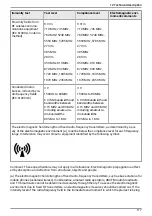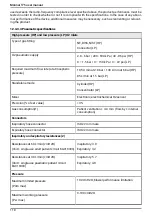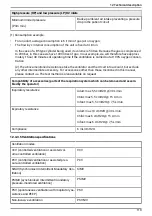
12 Technical description
However, it may well be that the mix concentration cannot be achieved since it depends:
•
on the type of concentrator and its settings (the O2 flow rate delivered by the concentrator is often
low and its O2 concentration variable
[between 90 and 100%]
);
•
on the ventilation parameters.
The following graph shows the maximum concentrations that can be obtained with different concen-
trator flow rates (based on an O2 concentration of 100%) according to the minute volume of a patient
ventilated at the frequency of 15 bpm.
For example, for a concentrator delivering 5 L/min and a patient ventilated in volumetric mode with a
Vt of 0.5 L and a frequency of 15 bpm (i.e.: a minute volume of 0.5x15 = 7.5 L/min), the maximum con-
centration that may be obtained will be approximately 50%. The device will then be capable of deliver-
ing any required concentration below this value.
Note:
Since the device only consumes the flow that it needs to ensure correct concentration
of the mixture, Air Liquide Medical Systems recommends that the low-pressure source be ad-
justed to its maximum flow rate. This will make it possible to obtain a wider range of possible
FiO2.
Whatever the function mode for the device, the oxygen sensor (O2S) ensures monitoring of the FiO2
concentration in the circuit.
This sensor is a chemical cell where an electrolytic reaction occurs. The current produced is propor-
tional to the partial pressure of oxygen.
However a compensation of this pressure is applied each time the automatic tests are lauched. Am-
bient humidity also affects the oxygen measurement at the rate of -0.03% per%Hr, at 25°C (see Mea-
sured parameters on page 122).
12.1.4 Special characteristics of nebulization
The O2 supply pressure (O2 HP) is reduced in the nebulization branch by the pressure reducer (PR1) at
a pressure of 1 bar.
The nebulization on/off solenoid valve (V2) provides nebulization via its open and closed positions.
The nebulization flow rate then depends on the nebulizer used.
12.1.5 CO2 monitoring
The CO2 (CO2S) sensor ensures monitoring of the CO2 concentration during the expiration of the pa-
tient.
12.2 Electrical power sources
he ventilator is compatible with various electrical power sources:
•
Mains supply;
•
Power supply on an external DC source (external battery);
•
Power supply on an internal DC source (internal battery ).
The electrical characteristics of each of these sources are described in Electrical specifications on
page 112.
Note:
If the unit suddenly shuts down during ventilation (e.g. battery empty), when the unit is
reconnected to the external or auxiliary power and restarted, it automatically resumes ventila-
tion with the last parameters saved.
105
Summary of Contents for MONNAL T75
Page 2: ......
















































